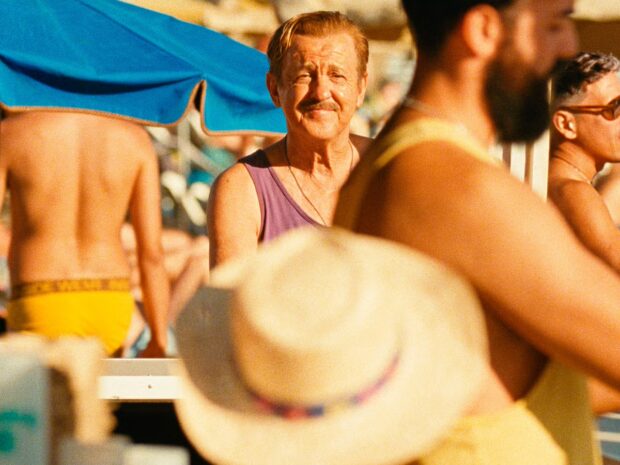Stories that Close the Circle
Por José Luis Lobera • 16/10/2025 • Cine & TV, Literatura

Maspalomas, a recently released Spanish film, tells the story of Vicente, a 76-year-old gay man who enjoys the beach and anonymous sex in the dunes of the Canary Islands. His life takes a drastic turn when he suffers a stroke, and his daughter—whom he hasn’t seen in many years—admits him to a nursing home in his hometown of San Sebastián.
The film reflects on the themes of aging, identity, and family, and its narrative technique is circular, since Vicente’s story (spoiler alert!) ends in Maspalomas, the same place where it began, after completing a transformation of his inner world.
Many stories conclude with a return to the place, moment or idea of the starting point, yet the main characters have embarked on a figurative journey that has seen them grow, overcome challenges, or transform. The bookends of the story may look the same, but the change has occurred in the invisible realm of the emotional and the spiritual.
Closing the Circle in Literature and Film
One of the earliest stories to follow this circular pattern is Homer’s Odyssey, in which the king Ulysses embarks on a ten-year journey from Ithaca to Troy. Upon returning to Ithaca, Ulysses comes back transformed into a wiser, more patient, and more respectful man after enduring a series of trials. He regains his throne with humility and deeper self-knowledge.
 The Little Prince by Antoine de Saint-Exupéry is another classic story that closes the circle. The story begins and ends in the Sahara Desert, but with a profound inner transformation of the narrator. At the beginning, the narrator recalls his childhood and his first drawing of an elephant swallowed by a boa—an image adults failed to understand, mistaking it for a hat. Over time, he becomes a pilot and loses touch with the imagination of his youth. It is only after crashing in the desert and meeting the Little Prince from another planet that he regains his ability to love, imagine, and see with the heart.
The Little Prince by Antoine de Saint-Exupéry is another classic story that closes the circle. The story begins and ends in the Sahara Desert, but with a profound inner transformation of the narrator. At the beginning, the narrator recalls his childhood and his first drawing of an elephant swallowed by a boa—an image adults failed to understand, mistaking it for a hat. Over time, he becomes a pilot and loses touch with the imagination of his youth. It is only after crashing in the desert and meeting the Little Prince from another planet that he regains his ability to love, imagine, and see with the heart.
In film, two of my favorite stories that follow this circular model are Groundhog Day (1993) and Everything Everywhere All at Once (2022). In Groundhog Day, the story follows a temporal circular model: the protagonist is trapped in a single day that keeps repeating itself. Phil, a cynical and self-centered TV weatherman, travels to the small town of Punxsutawney, Pennsylvania, to cover the traditional “Groundhog Day”. There he becomes stuck in a time loop—waking up every morning on the same day, February 2nd. Through countless repetitions of that same day, his gruff attitude toward the town and his colleagues gradually transforms him into a more generous and compassionate Phil. By the end of the story, Phil decides to stay in Punxsutawney with his coworker Rita, and the town he once despised becomes his place of redemption. One morning, he wakes up—and it’s finally February 3rd.
Meanwhile, the brilliant Everything Everywhere All at Once begins and ends in a laundromat. Evelyn, the main character, lives a monotonous life, overwhelmed by work and family. A visit to the IRS opens a portal through which she travels across multiple universes, experiencing alternative versions of herself. By the end of the film’s wild and dazzling journey, Evelyn returns to her ordinary life, but with a deeper appreciation for her family and her existence.
Quo Vadis: Exploring our Inner Shelves
From a scientific perspective, stories that close the circle are easier to remember because the human brain associates narrative closure with greater understanding, making the story more memorable. Fundamentally, this technique is recommended to content creators who wish to emphasize the importance of achieving a deeper understanding of the world—and of ourselves—through the exploration of our inner lives.
“We shall not cease from exploration,
and the end of all our exploring
will be to arrive where we started
and know the place for the first time.”
 The Little Prince by Antoine de Saint-Exupéry is another classic story that closes the circle. The story begins and ends in the Sahara Desert, but with a profound inner transformation of the narrator. At the beginning, the narrator recalls his childhood and his first drawing of an elephant swallowed by a boa—an image adults failed to understand, mistaking it for a hat. Over time, he becomes a pilot and loses touch with the imagination of his youth. It is only after crashing in the desert and meeting the Little Prince from another planet that he regains his ability to love, imagine, and see with the heart.
The Little Prince by Antoine de Saint-Exupéry is another classic story that closes the circle. The story begins and ends in the Sahara Desert, but with a profound inner transformation of the narrator. At the beginning, the narrator recalls his childhood and his first drawing of an elephant swallowed by a boa—an image adults failed to understand, mistaking it for a hat. Over time, he becomes a pilot and loses touch with the imagination of his youth. It is only after crashing in the desert and meeting the Little Prince from another planet that he regains his ability to love, imagine, and see with the heart.

Comentarios